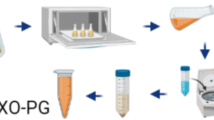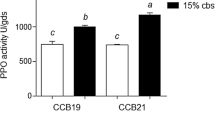Abstract
Phomopsis sp. XP-8 is an endophytic fungus that has the ability to produce pinoresinol diglucoside (PDG) in vitro and thus has potential application for the biosynthesis of PDG independent of plants. When cultivated in mung bean medium, PDG production was significantly improved and pinoresinol monoglucoside (PMG) and pinoresinol (Pin) were also found in the culture medium. In this experiment, starch, protein, and polysaccharides were isolated from mung beans and separately used as the sole substrate in order to explore the mechanism of fermentation and identify the major substrates that attributed to the biotransformation of PDG, PMG, and Pin. The production of PDG, PMG, and Pin was monitored using high-performance liquid chromatography (HPLC) and confirmed using HPLC-MS. Activities of related enzymes, including phenylalanine ammonia-lyase (PAL), trans-cinnamate 4-hydroxylase (C4H), and 4-coumarate-CoA ligase (4CL) were analyzed and tracked during the cultivation. The reaction system contained the compounds isolated from mung bean in the designed amount. Accumulation of phenylalanine, cinnamic acid, p-coumaric acid, PDG, PMG, and Pin and the activities of PAL, C4H, and 4CL were measured during the bioconversion. PMG was found only when mung bean polysaccharide was analyzed, while production of PDG and Pin were found when both polysaccharide and starch were analyzed. After examining the monosaccharide composition of the mung bean polysaccharide and the effect of the different monosaccharides had on the production of PMG, PDG, and Pin, galactose in mung bean polysaccharide proved to be the major factor that stimulates the production of PMG.







Similar content being viewed by others
References
Adlercreutz H (2002) Phyto-oestrogens and cancer. Lancet Oncol 3:364–373
Akihisa T, Orido M, Akazawa H, Takahashi A, Yamamoto A, Ogihara E, Fukatsu M (2013) Melanogenesis-inhibitory activity of aromatic glycosides from the stem bark of Acer buergerianum. Chem Biodivers 10:167–176
Aly AH, Debbab A, Kjer J, Proksch P (2010) Fungal endophytes from higher plants: a prolific source of phytochemicals and other bioactive natural products. Fungal Divers 41:1–16
Charles JS, Ravikumt PR, Huang FC (1976) Isolation and synthesis of pinoresinol diglucoside, a major antihypertensive principle of Tu-Chung (Eucommia ulmoides Oliv.). J Am Chem Soc 98:5412–5413
Chiang VL (2006) Monolignol biosynthesis and genetic engineering of lignin in trees, a review. Environ Chem Lett 4:143–146
Donnez D, Jeandet P, Clément C, Courot E (2009) Bioproduction of resveratrol and stilbene derivatives by plant cells and microorganisms. Trends Biotechnol 27:706–713
El-Adawy TA (2000) Functional properties and nutritional quality of acetylate and succinylated mung bean protein isolate. Food Chem 70:83–91
Elder T (2014) Bond dissociation enthalpies of a pinoresinol lignin model compound. Energy Fuel 28:1175–1182
Hwang B, Lee J, Liu QH, Woo ER, Lee DG (2010) Antifungal effect of (+)-pinoresinol isolated from Sambucus williamsii. Molecules 15(5):3507–3516
He XR, Wang JH, Li MX, Hao DJ, Yang Y, Zhang CL, He R, Tao R (2014) Eucommi aulmoides Oliv.: Ethnopharmacology, phytochemistry and pharmacology of an important traditional Chinese medicine. J Ethnopharmacol 151:78–92
Jung HW, Mahesh R, Lee JG, Lee SH, Kim YS, Park YK (2010) Pinoresinol from the fruits of Forsythia koreana inhibits inflammatory responses in LPS-activated microglia. Neurosci Lett 480:215–20
Kim HJ, Oh MS, Hong J, Jang YP (2011) Quantitative analysis of major dibenzocyclooctanelignans in schisandraefructusby online TLC-DART-MS. Phytochem Anal 22:258–262
Kusari S, Lamshöft M, Zühlke S, Spiteller M (2008) An endophytic fungus from Hypericum perforatum that produces hypericin. J Nat Prod 71:159–162
Lai F, Wen Q, Li L, Wu H, Li X (2010) Antioxidant activities of water-soluble polysaccharide extracted from mung bean (Vigna radiata L.) hull with ultrasonic assisted treatment. Carbohyd Polym 81:323–329
Landete JM (2012) Plant and mammalian lignans: a review of source, intake, metabolism, intestinal bacteria and health. Food Res Int 46(1):410–424
Luo LF, Wu WH, Zhou YJ, Yan J, Yang GP, Ouyang DS (2010) Antihypertensive effect of Eucommia ulmoides Oliv. extracts in spontaneously hypertensive rats. J Ethnopharmacol 129:238–243
Maisa B, Xu XY, Si YP, Arine H, Miao WH, Wang LF (2013) Effect of oxidation and esterification on functional properties of mung bean (Vigna radiata (L.) Wilczek) starch. Eur Food Res Technol 236:119–128
Mubarak AE (2005) Nutritional composition and antinutritional factors of mung bean seeds (Phaseolus aureus) as affected by some home traditional processes. Food Chem 89:489–495
Pietinen P, Stumpf K, Männistö S, Kataja V, Uusitupa M, Adlercreutz H (2001) Serum enterolactone and risk of breast cancer a case–control study in eastern Finland. Cancer Epidem Biomar 10:339–344
Randhir R, Lin YT, Shetty K (2004) Stimulation of phenolics, antioxidant and antimicrobial activities in dark germinated mung bean sprouts in response to peptide and phytochemical elicitors. Process Biochem 39:637–646
Randhir R, Shetty K (2007) Mung beans processed by solid-state bioconversion improves phenoliccontent and functionality relevant for diabetes and ulcer management. Innovat Food Sci Emerg Tech 8:197–204
Satake H, Ono E, Murata J (2013) Recent advances in the metabolic engineering of lignan biosynthesis pathways for the production of transgenic plant-based foods and supplements. J Agric Food Chem 61:11721–11729
Shi JL, Liu C, Liu LP, Yang BW, Zhang YZ (2012) Structure identification and fermentation characteristics of pinoresinol diglucoside produced by Phomopsis sp. isolated from Eucommia ulmoides Oliv. Appl Microbiol Biotechnol 93:1475–1483
Sih CJ, Ravikumt PR, Huang FC (1976) Isolation and synthesis of pinoresinol diglucoside, a major antihypertensive principle of Tu-Chung (Eucommia ulmoides Oliv.). J Am Chem Soc 98(17):5412–5413
Suzuki S, Umezawa T (2007) Biosynthesis of lignans and norlignans. J Wood Sci 53:273–284
Tsukamoto H, Hisada S, Nishide S (1984) Lignans from bark of Fraxinus mandshurica var. japonica and F. japonica. Chem Pharm Bull 32:4482–4489
Umezawa T (2005) Biosynthesis of lignans, lignins, and norlignans. Kagaku to Seibutsu 43:461–467
Vermerris W, Nicholson R (2006) Families of phenolic compounds and means of classification. Phenolic Compd Biochem 10:1–34
Xie LH, Akao T, Hamasaki K, Deyama T, Hattori M (2003) Biotransformation of pinoresinol diglucoside to mammalian lignans by human intestinal microflora, and isolation of Enterococcus faecalis strain PDG-1 responsible for the transformation of (+)-pinoresinol to (+)-lariciresinol. Chem Pharm Bull 51:508–515
Xie J, Tworoger SS, Franke AA, Terry KL, Rice MS, Rosner BA, Willett WC, Hankinson SE, Eliassen AH (2013) Plasma enterolactone and breast cancer risk in the Nurses’ Health Study II. Breast Cancer Res Treat 139:801–809
Yang B, Jiang YM, Zhao MM, Shi J, Wang LZ (2008) Effects of ultrasonic extraction on the physical and chemical properties of polysaccharide from longan fruit pericarp. Polym Degrad Stabil 93:268–272
Zhang JH, Shi JL, Liu YL (2013) Substrates and enzyme activities related to biotransformation of resveratrol from phenylalanine by Alternaria sp. MG1. Appl Microbiol Biotechnol 97:9941–9954
Author information
Authors and Affiliations
Corresponding author
Rights and permissions
About this article
Cite this article
Zhang, Y., Shi, J., Gao, Z. et al. Production of pinoresinol diglucoside, pinoresinol monoglucoside, and pinoresinol by Phomopsis sp. XP-8 using mung bean and its major components. Appl Microbiol Biotechnol 99, 4629–4643 (2015). https://doi.org/10.1007/s00253-015-6491-7
Received:
Revised:
Accepted:
Published:
Issue Date:
DOI: https://doi.org/10.1007/s00253-015-6491-7




